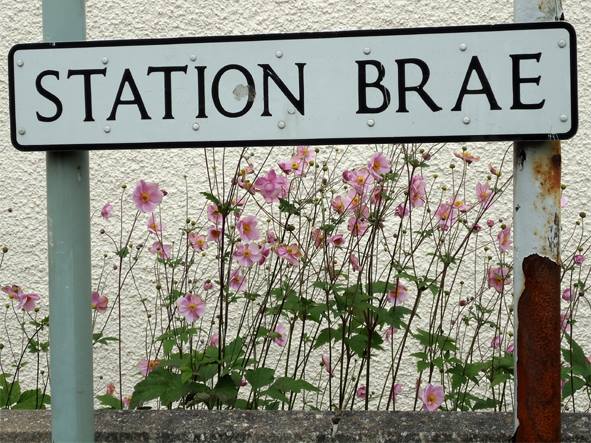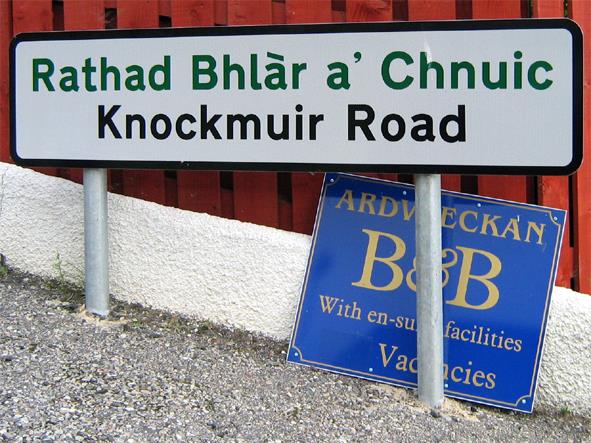Wir Ain Leed — North Northern Scots
Consonants
Consonants usually have the same phonetic values (pronunciation) in Scots, as in Standard English. For more detail see Orthography.
In Avoch and Cromarty initial <h> may be elided, wrong insertion of /h/ may also occur.
Medial and final <ch> is usually /x/ in words such as bocht, loch and nicht.
Initial <ch> is often /ʃ/ in words such as chap, chield, chirl and chowk.
The cluster <nch> is usually /nʃ/ in words such as brainch, clinch, dunch, hainch, inch and French.
The trigraph <tch> is usually /ʧ/ in words such as fleetch and wratch.
Final <k> and < ck> are often /g/, particularly in Caithness, in words such as bannock, hillock and lassieock.
The trigraph <dge> is usually /ʤ/ in words such as begrudge, cadge, cruldge and fadge.
The grapheme <g> is usually /ʤ/, however, in Caithness initially it may be /ʧ/, in words such as breinge, gigot and gin.
Initial <gn> may be /gn/ in words such as gnap and gnaw.
Initial <j> is usually /ʧ/ in words such as Jean, jeely and jyle.
Initial <kn> is usually /n/, however, in Caithness it may be /kn/, and in the Black Isle and Easter Ross it may be /kr/, in words such as knap, knee, knot and knowe.
Final <ld> before a word begining with a consonant is usually simplified to /l/ in words such as auld, bield, cauld and fauld, otherwise it is /ld/ in words such as elder.
The cluster <nd> is usually simplified to /n/ in words such as baund, daunder, find, haund and sindry.
The digraph <ng> is usually /ŋ/ in words such as finger, hing, ingan and single.
The digraph <nk> is usually /ŋk/ in words such as bink and hank.
The digraph <qu> is usually /kw/ in words such as acquent, quair and queen.
The digraph <sh> is usually /ʃ/ in words such as creash and sheep. That may occasionally be /ʒ/ in words such as fushion and pushion.
Final <it> is often /ɪd/, particularly in Caithness, in words such as droukit, it, mairit and semmit. That also occurs in words such as lempet and packet.
The digraph <th> is usually /θ/ in words such as graith, thole and thrawn and /ð/ in words such as blether, thaim, thair. However, Initial <th> is often silent in pronominals such as the, thair, thare, thee and thoo.
The digraph <wh> is usually /f/, in Cromarty /ʍ/ prevails and in some words in other areas, in words such as wha, whan, wheech, and wheel. In the Black Isle and Easter Ross <wh> may be omitted or replaced by /h/ in words such as wha, whan, whase and whit.
Initial <wr> is often /vr/ in words such as wrack, wrang, wricht and write.
Vowels and Diphthongs
The unstressed vowel /ə/ may be aboot, the, oxter, duntit, bannock and smeddum.
Initial <a> is usually /ə/ in words such as ahint and awa etc.
The grapheme <a> is usually /a/, in the Black Isle and Easter Ross /əi/ may occur before <n> and <ng>, in words such as aff, lang, mak, wash and watch.
 Thurso, Caithness
Thurso, CaithnessInitial and medial <au> is usually /aː/, but may be /ɑ/ before <l>, <n>, <r> and <ch> (/x/), in words such as auld, haud, haund, saul, saund and slauchter. In Caithnes the cluster <auld> may be /ʌul(d)/.
Final <aw> is usually /aː/ in words such as aw, blaw, caw, draw, faw, gaw, gnaw, haw, slaw, snaw and staw. That may also occur initially and medially in a few words such as awn, awfu, bawbee and bawsant.
The digraph <aa> /aː/ is only used in a few Caithness words derived from Norn.
 Lybster Caithness
Lybster CaithnessInitial and medial <ai> is usually /əi/, however, /e/ is becoming predominant, in words such as aiblins, aik, aiple, ait, aith, braid, craitur, fain, gaither, graith and haimer.
The cluster <a-e> is usually /əi/, however, /e/ is becoming predominant, in words such as alane, ale, ane, ance, bane, face, gane, gate, hame, mane, nane, stane and Pace.
 Munlochy, The Black Isle
Munlochy, The Black IsleFinal <ae> is usually /e/ in words such as ae, brae, f(r)ae, gae, sae, tae n. and wae. However, <ae> is /i/ in adae, dae, shae and tae v.
Final <ay> ia usually /e/ in words such as day, gray and lay.
The digraph <ea> is usually /əi/, however, /e/ is becoming predominant, in words such as beast, cheap, deave, east, heap, hear, meat, ream, sea, tea.
The digraph <ee> is usually /i/ in words such as dee, dree, eetem, freet, jeelie, keep, meet, teeth, weel and weet.
The digraph <ei> is usually /əi/, however, /e/ is becoming predominant, in words such as beir, deid, heid, meidae, peir, spreid, teir and threid.
Before /x/ <ei> is usually /i/ in words such as dreich, heich and skeich.
The digraphs <ie> and <ei> are usually /i/ in words such as bield, chield, eild, scrieve, shielin.
The grapheme <e> is usually /ɛ/ in words such as bed, ebb, esh, fecht, gled, gless, seck and wecht.
The grapheme <i> is usually /ɛ/ in words such as drink, in, inch, licht, lift, pit, rin, simmer, sin, stibble, whin, whisper, whit, wid, wind, wir, wird, wirm and wittins. In the Black Isle and Easter Ross before /g/ and /x/ it may be /əi/ in words such as big, nicht, pig and sicht.
The graphemes <o> and <oa> are usually /o/ in words such as boat, boss, box, coal, cod, common, dochter, hoast, loch, on, rock, thocht.
The digraph <oo> is usually /y/ in words such as aboot, coont, droop, hoose, moose, oot, scoor and soond.
The digraph <ou> is usually /y/ in words such as allou, bouk, broun, coum, cour, doun, dout, poupit and thoum.
The cluster <u-e> is usually /y/ in words such as dule and hure.
The grapheme <u> is usually /ʌ/ in words such as bund, burn, drunken, fund, grund, truff, unce and wund.
 Avoch, The Black Isle
Avoch, The Black IsleThe digraph <ui> is usually /i/, however, /ø/ or /y/ may occur, in words such as abuin, abuise, bluid, bruit, cuil, cuit, duin, fruit, guid, luif, luim, muin, muisic, ruise, schuil, spuin, uise, uiss and Yuil. Before <r>, <ui>, may be /ju:/ in words such as buird, fluir, fuird, muir, shuir.
The digraph <eu> is usually /ju/ in words such as beuch, beuk, eneuch, heuk, leuch, leuk, neuk, sheuch, teuch, teug, however, /jɔ/ may occur in words like eneuch.
The digraph <ew> is usually /jy/ in words such as dew, few, new and spew.
 Cromarty, The Black Isle
Cromarty, The Black IsleThe clusters <i-e> and <y-e> are usually /əi/ in words such as advice, bide, bile, fine, fire, ile, rive, tyne, wise adj., wyte, however, /oi/ may occur in words like bide, byke, line and pipe.
The graphemes <ey> and <ye> are usually /əi/ in words such as cry, eyntment, eyster, fley and kye.
The digraphs <oi> and <oy> are usually /oi/ in words such as Boid, foy, noise and ploy.
 Thurso, Caithness
Thurso, CaithnessInitial and medial <ow> is susually /ʌu/ words such as bowt, cowp, cowt, gowd, gowf, lowp and owsen. Root final that is <owe> in words such as flowe, glowe, growe, howe, knowe, lowe, rowe and towe.
Suffixes
Strictly speaking not a suffix, <ae> is usually /ə/ in words such as Americae, airae, barrae, nairae, swallae and windae.
Diminutive <ie> is usually /i/ in words such as grannie, laddie, lassie, shappie and wifie.
Diminutive <ock> is usually /əg/ in words such as bannock, hillock and lassieock.
Adjectival <fu> is usually /fɛ/ in words such as awfu, carefu and mensefu.
The negative particle <na> is usually /nə/ in words such as daena (dinna), haesna, maunna, winna and wisna.
The verbal endings <t> and <it> are usually /t/ and /ɪt/, in Caithness those are /d/ and /əd/ in words such as scunnert, selt, telt, duntit and skelpit.
Adverbial and adjectival <y> and <ie> Are usually /i/, however, If the preceding vowel is /i/ or /əi/, or the preceding consonant is /b, d, ð, g, v, ʒ/ or /z/, it is /i/, otherwise /ɪ/, in words such as reekie, sairy, stany and stourie.
Adverbial <ly> is usually /li/, however, If the preceding vowel is /i/ or /əi/, or the preceding consonant is /b, d, ð, g, v, ʒ/ or /z/, it is /li/, otherwise /lɪ/, in words such as brawly, feckly, fully,geyly, likely and uncoly.
Thae and thir are replaced by the plural use of this and that.
Older speakers still differentiate the present participle and the gerund (verbal noun). In older Scots the present participle was written <and> /an(d)/ and the gerund <ing> /ɪn/. Those pronunciations are still used.
He was always roaming around.
He likes roaming around.
The diminutive suffix <ock> when pronounced /əg/ and may be written <ag>: The wee bairnag - The small child.
Literature:
Mather, James (1978) "The dialect of Caithness", Scottish Literary Journal Supplement 6, 1-16.
Nicolson, D. B. (1907) "Dialect" in J. Horne ed. The County of Caithness, Wick: W. Rae, 60-68.
Mather, James Y. and H. H. Speitel (1986) The Linguistic Atlas of Scotland volume 3, London: Croom Helm.
Johnston, Paul (1997) "Regional variation" in Charles Jones ed. The Edinburgh History of the Scots Language, Edinburgh University Press, 443-513.
